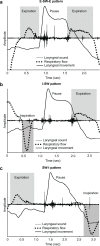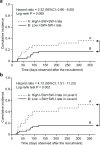Breathing-swallowing discoordination is associated with frequent exacerbations of COPD
- PMID: 28883930
- PMCID: PMC5531308
- DOI: 10.1136/bmjresp-2017-000202
Breathing-swallowing discoordination is associated with frequent exacerbations of COPD
Abstract
Introduction: Impaired coordination between breathing and swallowing (breathing-swallowing discoordination) may be a significant risk factor for the exacerbation of chronic obstructive pulmonary disease (COPD). We examined breathing-swallowing discoordination in patients with COPD using a non-invasive and quantitative technique and determined its association with COPD exacerbation.
Methods: We recruited 65 stable outpatients with COPD who were enrolled in our prospective observational cohort study and did not manifest an apparent swallowing disorder. COPD exacerbation was monitored for 1 year before and 1 year after recruitment. Swallowing during inspiration (the I-SW pattern) and swallowing immediately followed by inspiration (the SW-I pattern) were identified.
Results: The mean frequency of the I-SW and/or SW-I patterns (I-SW/SW-I rate) was 21.5%±25.5%. During the 2-year observation period, 48 exacerbation incidents (25 patients) were identified. The I-SW/SW-I rate was significantly associated with the frequency of exacerbation. During the year following recruitment, patients with a higher I-SW/SW-I frequency using thicker test foods exhibited a significantly higher probability of future exacerbations (p=0.002, log-rank test).
Conclusions: Breathing-swallowing discoordination is strongly associated with frequent exacerbations of COPD. Strategies that identify and improve breathing-swallowing coordination may be a new therapeutic treatment for patients with COPD.
Keywords: COPD Exacerbations; Lung Physiology; Respiratory Measurement.
Figures



Similar articles
-
Breathing-Swallowing Discoordination and Inefficiency of an Airway Protective Mechanism Puts Patients at Risk of COPD Exacerbation.Int J Chron Obstruct Pulmon Dis. 2020 Jul 13;15:1689-1696. doi: 10.2147/COPD.S257622. eCollection 2020. Int J Chron Obstruct Pulmon Dis. 2020. PMID: 32764914 Free PMC article.
-
Inappropriate Timing of Swallow in the Respiratory Cycle Causes Breathing-Swallowing Discoordination.Front Physiol. 2017 Sep 22;8:676. doi: 10.3389/fphys.2017.00676. eCollection 2017. Front Physiol. 2017. PMID: 28970804 Free PMC article.
-
Swallowing disorder - A possible therapeutic target for preventing COPD exacerbations.Respir Physiol Neurobiol. 2023 Jul;313:104061. doi: 10.1016/j.resp.2023.104061. Epub 2023 Apr 12. Respir Physiol Neurobiol. 2023. PMID: 37059160 Review.
-
Effects of noninvasive ventilation on the coordination between breathing and swallowing in patients with chronic obstructive pulmonary disease.Int J Chron Obstruct Pulmon Dis. 2019 Jul 8;14:1485-1494. doi: 10.2147/COPD.S205543. eCollection 2019. Int J Chron Obstruct Pulmon Dis. 2019. PMID: 31371935 Free PMC article.
-
Exacerbations of chronic obstructive pulmonary disease.Respir Care. 2003 Dec;48(12):1204-13; discussion 1213-5. Respir Care. 2003. PMID: 14651761 Review.
Cited by
-
Association between swallowing dynamics, tongue pressure and pulmonary function in patients with idiopathic pulmonary fibrosis.BMC Pulm Med. 2024 Jul 4;24(1):315. doi: 10.1186/s12890-024-03117-3. BMC Pulm Med. 2024. PMID: 38965496 Free PMC article.
-
Videofluoroscopic measures of swallowing in people with stable COPD compared to healthy aging.Codas. 2023 Oct 23;36(1):e20220260. doi: 10.1590/2317-1782/20232022260. eCollection 2023. Codas. 2023. PMID: 37878956 Free PMC article.
-
Swallow-breathing coordination during incremental ascent to altitude.Respir Physiol Neurobiol. 2019 Jul;265:121-126. doi: 10.1016/j.resp.2018.06.005. Epub 2018 Jun 18. Respir Physiol Neurobiol. 2019. PMID: 29920337 Free PMC article.
-
Risk Factors for Dysphagia in Patients Hospitalized with COVID-19.Dysphagia. 2023 Jun;38(3):933-942. doi: 10.1007/s00455-022-10518-1. Epub 2022 Sep 15. Dysphagia. 2023. PMID: 36109398 Free PMC article.
-
Breathing-Swallowing Discoordination and Inefficiency of an Airway Protective Mechanism Puts Patients at Risk of COPD Exacerbation.Int J Chron Obstruct Pulmon Dis. 2020 Jul 13;15:1689-1696. doi: 10.2147/COPD.S257622. eCollection 2020. Int J Chron Obstruct Pulmon Dis. 2020. PMID: 32764914 Free PMC article.
References
-
- Seemungal TA, Donaldson GC, Paul EA, et al. . Effect of exacerbation on quality of life in patients with chronic obstructive pulmonary disease. Am J Respir Crit Care Med 1998;157:1418–22.doi:10.1164/ajrccm.157.5.9709032 - DOI - PubMed
-
- Soler-Cataluña JJ, Martínez-García MA, Román Sánchez P, et al. . Severe acute exacerbations and mortality in patients with chronic obstructive pulmonary disease. Thorax 2005;60:925–31.doi:10.1136/thx.2005.040527 - DOI - PMC - PubMed
-
- Terada K, Muro S, Sato S, et al. . Impact of gastro-oesophageal reflux disease symptoms on COPD exacerbation. Thorax 2008;63:951–5.doi:10.1136/thx.2007.092858 - DOI - PubMed
-
- Hurst JR, Vestbo J, Anzueto A, et al. . Evaluation of copd longitudinally to identify predictive surrogate endpoints investigators. susceptibility to exacerbation in chronic obstructive pulmonary disease. N Engl J Med 2010;363:1128–38. - PubMed
-
- Mokhlesi B, Morris AL, Huang CF, et al. . Increased prevalence of gastroesophageal reflux symptoms in patients with COPD. Chest 2001;119:1043–8.doi:10.1378/chest.119.4.1043 - DOI - PubMed
LinkOut - more resources
Full Text Sources
Other Literature Sources
